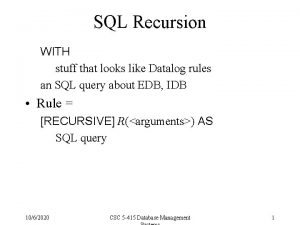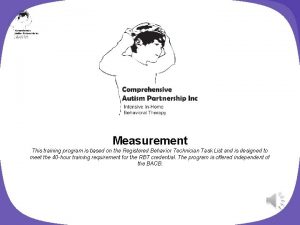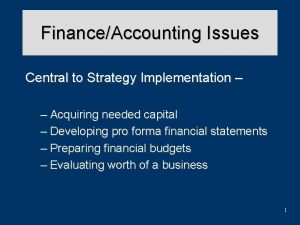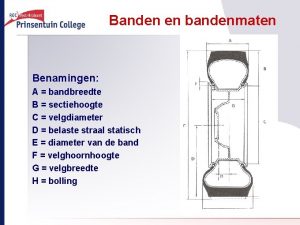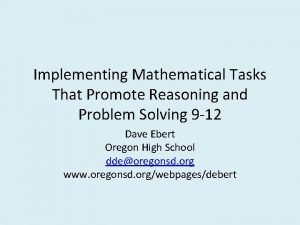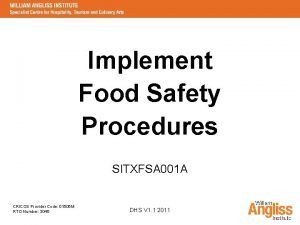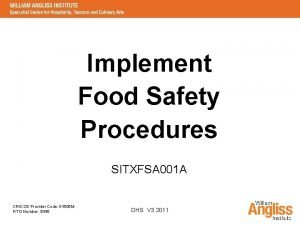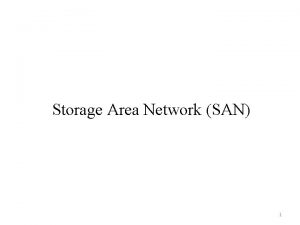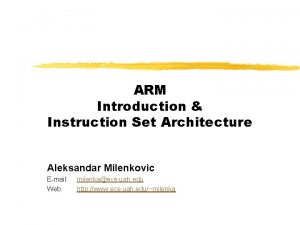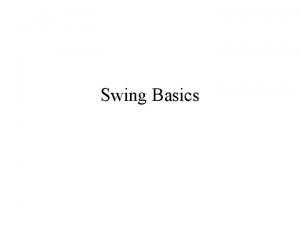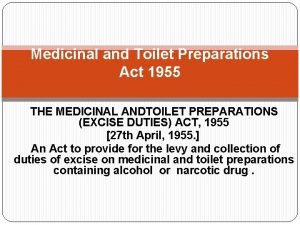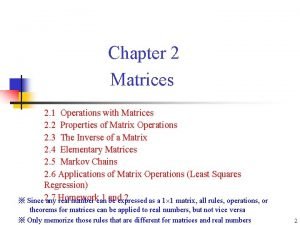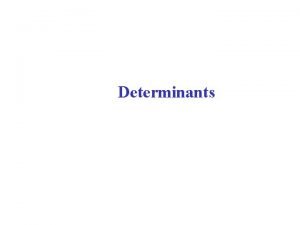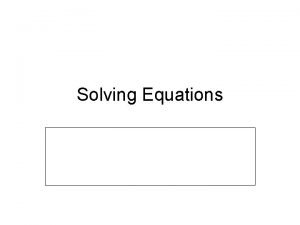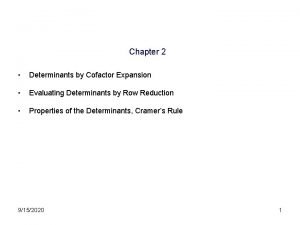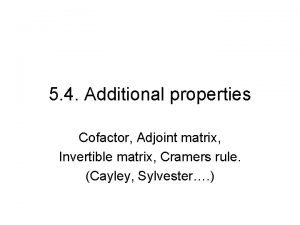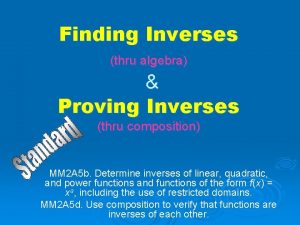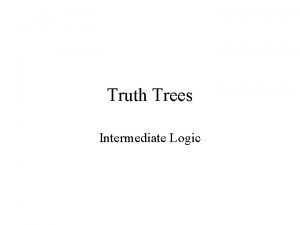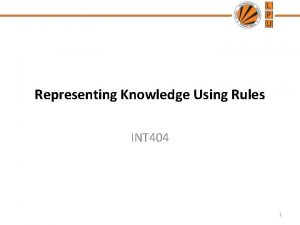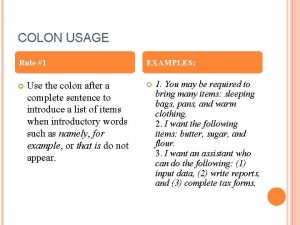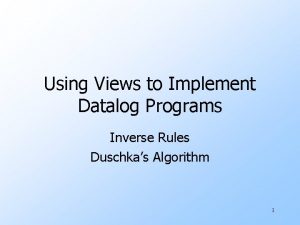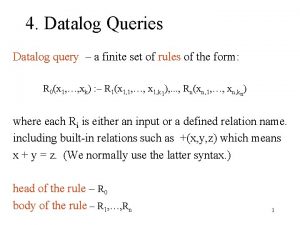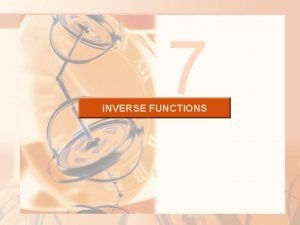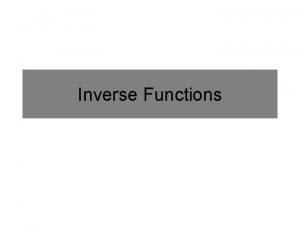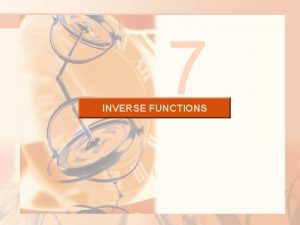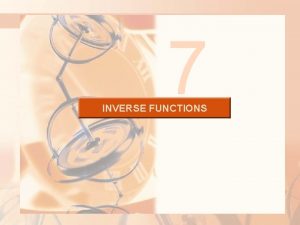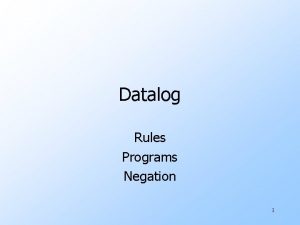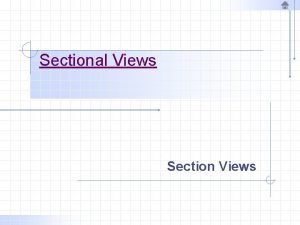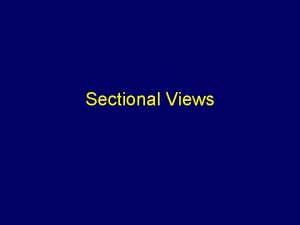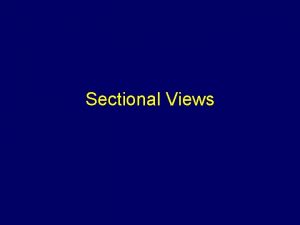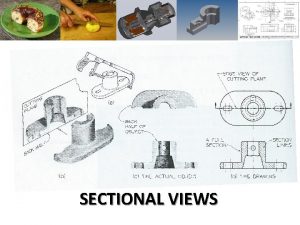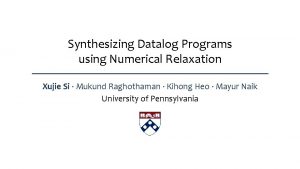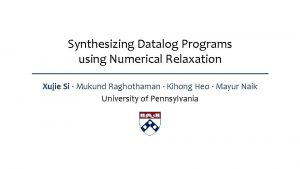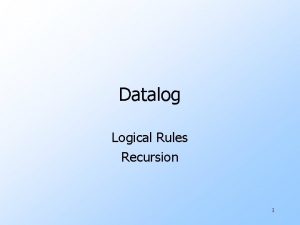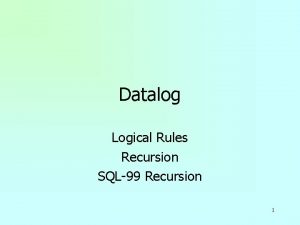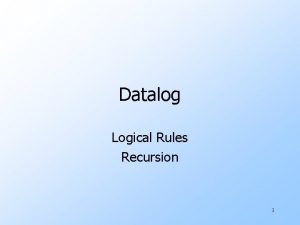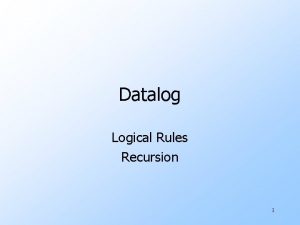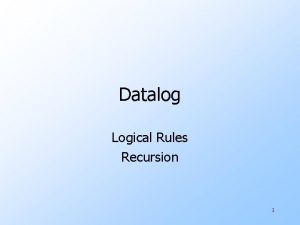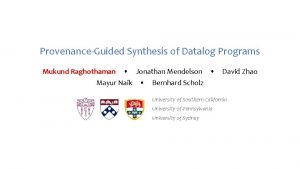Using Views to Implement Datalog Programs Inverse Rules





































- Slides: 37

Using Views to Implement Datalog Programs Inverse Rules Duschka’s Algorithm 1

Inverting Rules u. Idea: “invert” the view definitions to give the global predicates definitions in terms of views and function symbols. u. Plug the globals’ definitions into the body of the query to get a direct expansion of the query into views. u. Even works when the query is a program. 2

Inverting Rules --- (2) u. But the query may have function symbols in its solution, and these symbols actually have no meaning. u. We therefore need to get rid of them. u. Trick comes from Huyn -> Qian -> Duschka. 3

Skolem Functions u. Logical trick for getting rid of existentially quantified variables. u. In terms of safe Datalog rules: w For each local (nondistinguished) variable X, pick a new function symbol f (the Skolem constant). w Replace X by f (head variables). 4

Example v(X, Y) : - p(X, Z) & p(Z, Y) u. Replace Z by f(X, Y) to get: v(X, Y) : - p(X, f(X, Y)) & p(f(X, Y) u. Intuition: for v(X, Y) to be true, there must be some value, depending on X and Y, that makes the above body true. 5

HQD Rule Inversion u Replace a Skolemized view definition by rules with: 1. A subgoal as the head, and 2. The view itself as the only subgoal of the body. 6

Example v(X, Y) : - p(X, f(X, Y)) & p(f(X, Y) becomes: p(X, f(X, Y)) : - v(X, Y) p(f(X, Y) : - v(X, Y) 7

Running Example: Maternal Ancestors u. Global predicates: w m(X, Y) = “Y is the mother of X. ” w f(X, Y) = “Y is the father of X. ” umanc rules: r 1: manc(X, Y) : - m(X, Y) r 2: manc(X, Y) : - f(X, Z) & manc(Z, Y) r 3: manc(X, Y) : - m(X, Z) & manc(Z, Y) 8

Example --- Continued u. The views: v 1(X, Y) : - f(X, Z) & m(Z, Y) v 2(X, Y) : - m(X, Y) u. Inverse rules: r 4: f(X, g(X, Y)) : - v 1(X, Y) r 5: m(g(X, Y) : - v 1(X, Y) r 6: m(X, Y) : - v 2(X, Y) 9

Evaluating the Rules u. Treat views as EDB. u. Apply seminaïve evaluation to query (Datalog program). u. In general, function symbols -> no convergence. 10

Evaluating the Rules u. But here, all function symbols are in the heads of global predicates. u. These are like EDB as far as the query is concerned, so no nested function symbols occur. u. One level of function symbols assures convergence. 11

Example r 1: r 2: r 3: r 4: r 5: r 6: manc(X, Y) : - m(X, Y) manc(X, Y) : - f(X, Z) & manc(Z, Y) manc(X, Y) : - m(X, Z) & manc(Z, Y) f(X, g(X, Y)) : - v 1(X, Y) m(g(X, Y) : - v 1(X, Y) m(X, Y) : - v 2(X, Y) u. Assume v 1(a, b). 12

Example --- (2) r 1: r 2: r 3: r 4: r 5: r 6: manc(X, Y) : - m(X, Y) manc(X, Y) : - f(X, Z) & manc(Z, Y) manc(X, Y) : - m(X, Z) & manc(Z, Y) f(a, g(a, b)) : - v 1(a, b) m(g(a, b) : - v 1(a, b) m(X, Y) : - v 2(X, Y) u. Assume v 1(a, b). 13

Example --- (3) r 1: r 2: r 3: r 4: r 5: r 6: manc(g(a, b) : - m(g(a, b) manc(X, Y) : - f(X, Z) & manc(Z, Y) manc(X, Y) : - m(X, Z) & manc(Z, Y) f(a, g(a, b)) : - v 1(a, b) m(g(X, Y) : - v 1(X, Y) m(X, Y) : - v 2(X, Y) u. Assume v 1(a, b). 14

Example --- (4) r 1: manc(X, Y) : - m(X, Y) r 2: manc(a, b) : - f(a, g(a, b)) & manc(g(a, b) r 3: manc(X, Y) : - m(X, Z) & manc(Z, Y) r 4: f(X, g(X, Y)) : - v 1(X, Y) r 5: m(g(X, Y) : - v 1(X, Y) r 6: m(X, Y) : - v 2(X, Y) u. Assume v 1(a, b). 15

Example --- Concluded u. Notice that given v 1(a, b), we were able to infer manc(a, b), even though we never found out what the value of g(a, b) [the father of a ] is. 16

Rule-Rewriting u. Duschka’s approach moves the function symbols out of the seminaïve evaluation and into a rule-rewriting step. u. In effect, the function symbols combine with the predicates. w Possible only because there are never any nested function symbols. 17

Necessary Technique: Unification u. We unify two atoms by finding the simplest substitution for the variables that makes them identical. u. Linear-time algorithm known. 18

Example u. The unification of p(f(X, Y), Z) and p(A, g(B, C)) is p(f(X, Y), g(B, C)). u. Uses A -> f(X, Y); Z -> g(B, C); identity mapping on other variables. up(X, X) and p(Y, f(Y)) have no unification. u. Neither do p(X) and q(X). 19

Elimination of Function Symbols u Repeat: 1. Take any rule with function symbol(s) in the head. 2. Unify that head with any subgoals, of any rule, with which it unifies. 1. But first make head variables be new, unique symbols. u Finally, replace IDB predicates + function-symbol patterns by new predicates. 20

Example r 1: r 2: r 3: r 4: r 5: r 6: manc(X, Y) : - m(X, Y) manc(X, Y) : - f(X, Z) & manc(Z, Y) manc(X, Y) : - m(X, Z) & manc(Z, Y) f(X, g(X, Y)) : - v 1(X, Y) m(g(X, Y) : - v 1(X, Y) m(X, Y) : - v 2(X, Y) Unify 21

Example --- (2) r 2: manc(X, Y) : - f(X, Z) & manc(Z, Y) r 4: f(A, g(B, C)) : r 7: manc(X, Y) : - f(X, g(B, C)) & manc(g(B, C), Y) Important point: in the unification of X and A, any variable could be used, but it must appear in both these places. 22

Example --- (3) r 1: manc(X, Y) : - m(X, Y) r 3: manc(X, Y) : - m(X, Z) & manc(Z, Y) r 5: m(g(A, B), C) : r 8: manc(g(A, B), Y) : - m(g(A, B), Y) r 9: manc(g(A, B), Y) : - m(g(A, B), Z) & manc(Z, Y) 23

Example --- (4) u. Now we have a new pattern: manc(g(A, B), C). u. We must unify it with manc subgoals in r 2, r 3, r 7, and r 9. ur 2 and r 7 yield nothing new, but r 3 and r 9 do. 24

Example --- (5) r 3: manc(X, Y) : - m(X, Z) & manc(Z, Y) r 9: manc(g(A, B), Y) : - m(g(A, B), Z) & manc(Z, Y) manc(g(C, D), E) r 10: manc(X, Y) : - m(X, g(A, B)) & manc(g(A, B), Y) r 11: manc(g(A, B), Y) : m(g(A, B), g(C, D)) & manc(g(C, D), Y) 25

Cleaning Up the Rules 1. For each IDB predicate (manc in our example) introduce a new predicate for each function-symbol pattern. 2. Replace EDB predicates (m and f in our example) by their definition in terms of views, but only if no function symbols are introduced. 26

Justification for (2) u. A function symbol in a view is useless, since the source (stored) data has no tuples with function symbols. u. A function symbol in an IDB predicate has already been taken care of by expanding the rules using all functionsymbol patterns we can construct. 27

New IDB Predicates u. In our example, we only need manc 1 to represent the pattern manc(g(. , . ). u. That is: manc 1(X, Y, Z) = manc(g(X, Y), Z). 28

Example --- r 1: manc(X, Y) : - m(X, Y) r 5: m(g(X, Y) : - v 1(X, Y) r 6: m(X, Y) : - v 2(X, Y) Substitution OK; yields manc(X, Y) : - v 2(X, Y) Illegal --- yields g in head. Note the case manc(g(. , . ) is taken care of by r 8. 29

Example --- r 2 and r 3 r 2: r 3: r 4: r 5: r 6: manc(X, Y) : - f(X, Z) & manc(Z, Y) manc(X, Y) : - m(X, Z) & manc(Z, Y) f(X, g(X, Y)) : - v 1(X, Y) m(g(X, Y) : - v 1(X, Y) m(X, Y) : - v 2(X, Y) Illegal --- put function symbol g in manc. OK; yields manc(X, Y) : - v 2(X, Z) & manc(Z, Y) 30

Example --- r 4, r 5, r 6 u. The inverse rules have played their role and do not appear in the final rules. 31

Example --- r 7: manc(X, Y) : - f(X, g(B, C)) & manc(g(B, C), Y) r 4: f(X, g(X, Y)) : - v 1(X, Y) Unify. Note no function symbols are introduced, but X =B. Replace by manc 1(B, C, Y). r 7: manc(X, Y) : - v 1(X, C) & manc 1(X, C, Y) 32

Example --- r 8 and r 9 r 8: manc(g(A, B), Y) : - m(g(A, B), Y) r 9: manc(g(A, B), Y) : - m(g(A, B), Z) & manc(Z, Y) r 5: m(g(X, Y) : - v 1(X, Y) Become manc 1(A, B, Y) Unify; set B = Y. Unify; set B = Z. r 8: manc 1(A, Y, Y) : - v 1(A, Y) r 9: manc 1(A, Z, Y) : - v 1(A, Z)& manc(Z, Y) 33

Example --- r 10 and r 11 u. No substitutions possible --- unifying m –subgoal with head of r 5 or r 6 introduces a function symbol into the view subgoal. 34

Summary of Rules r 1: manc(X, Y) : - v 2(X, Y) r 3: manc(X, Y) : - v 2(X, Z) & manc(Z, Y) r 7: manc(X, Y) : - v 1(X, C) & manc 1(X, C, Y) r 8: manc 1(A, Y, Y) : - v 1(A, Y) r 9: manc 1(A, Z, Y) : - v 1(A, Z)& manc(Z, Y) 35

Finishing Touch: Replace manc 1 Substitute the bodies of r 8 and r 9 for the manc 1 subgoal of r 7: manc(X, Y) : - v 1(X, C) & manc 1(X, C, Y) r 8: manc 1(A, Y, Y) : - v 1(A, Y) r 9: manc 1(A, Z, Y) : - v 1(A, Z)& manc(Z, Y) Becomes another v 1(X, C) & manc(C, Y) 36

Final Rules r 1: r 3: manc(X, Y) : - v 2(X, Y) manc(X, Y) : - v 2(X, Z) & manc(Z, Y) r 7 -8: manc(X, Y) : - v 1(X, Y) r 7 -9: manc(X, Y) : - v 1(X, C) & manc(C, Y) 37
 Datalog vs sql
Datalog vs sql Datalog
Datalog Datalog semantic web
Datalog semantic web Datalog tutorial
Datalog tutorial C program to add two polynomials using linked list
C program to add two polynomials using linked list Disadvantages of waterfall model in software engineering
Disadvantages of waterfall model in software engineering Reiser implement
Reiser implement Permanent product recording aba
Permanent product recording aba Implement steer
Implement steer Acquiring capital to implement strategies
Acquiring capital to implement strategies Implementing strategies management and operations issues
Implementing strategies management and operations issues Implement profiel banden
Implement profiel banden Eschew the implement of correction and vitiate the scion
Eschew the implement of correction and vitiate the scion Implement tasks that promote reasoning and problem solving
Implement tasks that promote reasoning and problem solving Sitxfsa001a
Sitxfsa001a Implement food safety procedures
Implement food safety procedures Develop vs implement
Develop vs implement Your startup wants to implement an order fulfillment
Your startup wants to implement an order fulfillment Types of san storage
Types of san storage Why are user interfaces hard to implement
Why are user interfaces hard to implement Change advisory board
Change advisory board Arm instruction set architecture
Arm instruction set architecture Classes salsa and swing implement an interface dance
Classes salsa and swing implement an interface dance Medicinal preparation definition
Medicinal preparation definition Implement imi
Implement imi Develop and implement a food safety program
Develop and implement a food safety program Implement
Implement Inverse matrix rules
Inverse matrix rules Inverse of determinant
Inverse of determinant Example of inverse operations
Example of inverse operations Determinants by cofactor expansion
Determinants by cofactor expansion Cofactor matrix
Cofactor matrix Proving inverse functions using composition
Proving inverse functions using composition Truth tree branching rules
Truth tree branching rules Unlike traditional production rules, association rules
Unlike traditional production rules, association rules Representing knowledge using rules
Representing knowledge using rules Comma or colon after salutation
Comma or colon after salutation Using system.collections
Using system.collections
